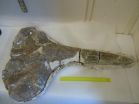INFORMATION:
Founded in 1989, The North American Menopause Society (NAMS) is North America's leading nonprofit organization dedicated to promoting the health and quality of life of all women during midlife and beyond through an understanding of menopause and healthy aging. Its multidisciplinary membership of 2,000 leaders in the field--including clinical and basic science experts from medicine, nursing, sociology, psychology, nutrition, anthropology, epidemiology, pharmacy, and education--makes NAMS uniquely qualified to serve as the definitive resource for health professionals and the public for accurate, unbiased information about menopause and healthy aging. To learn more about NAMS, visit http://www.menopause.org.
Hormones with statins may help women's hearts after menopause
2015-03-17
(Press-News.org) CLEVELAND, Ohio (March 17, 2015)--Hormones may not protect women from heart disease or stroke after menopause, but when combined with cholesterol-lowering statin drugs, they may help protect women from these killers, shows a population study from Sweden to be published in the April issue of Menopause, the journal of The North American Menopause Society (NAMS). During the study, women who took both hormones and statins had a significantly lower risk of dying of any cause and a moderately lower risk of dying of cardiovascular disease.
Using health information from national Swedish health registers on some 40,000 women who took statins, this study compared the records of deaths and cardiovascular events, such as heart attack and stroke, between some 3,000 women who also used hormone therapy and some 38,000 who did not. They were followed up for a mean of four years. Most of the women (70%) were using statins for primary prevention of heart disease, that is, they had not had a cardiovascular event such as heart attack or stroke. The others had had an event so were taking statins for secondary prevention.
The rate of death from any cause was 33/10,000 person-years for women who used hormone therapy with statins compared with 87/10,000 person years for women who used statins alone--a significant difference. Although the rates of cardiovascular events, such as heart attack or stroke, were no different between the groups, the rates of death from cardiovascular disease were lower in the women who used both therapies (5/10,000 person years) than in the women who used statins alone (18/10,000 person years), but this difference was not as definite statistically. These differences were consistent whether the women took statins for primary or for secondary prevention.
The potential beneficial effect on cardiovascular deaths contrasts with the results of the Women's Health Initiative (WHI) and the Heart and Estrogen/progestin Replacement Study (HERS). The reason, the researchers speculated, might be that women in the WHI and HERS took conjugated estrogens, which aren't available in Sweden, whereas the Swedish women used 17-beta estradiol, the estrogen that women most commonly make before menopause. The authors pointed out that a European study with hormone therapy using 17-beta estradiol showed some reduced, not increased, risk of death and heart attack.
Another reason, they said, is that statins may lessen the risk of coronary heart events that tend to occur early on in hormone therapy. That is because estrogen may make plaque in the arteries unstable, leading to blood clots and heart attacks and strokes.
As an accompanying editorial pointed out, in the HERS study, heart attacks did increase soon after women began taking hormones, but there was a significant decrease in heart disease after that. Combining hormone therapy with statins might be an advantage not only by preventing early heart attacks and offering cardiovascular benefits later but also by avoiding the onset of type-2 diabetes that statins may cause. These are questions that a properly conducted, randomized trial could answer, the editorial said.
"This report provides intriguing information on the benefits of simultaneous use of statins and hormone therapy in women considered to be at risk for cardiovascular disease. Its findings suggest that one benefit of each treatment offsets one adverse effect of the other treatment, thereby yielding better health outcomes in combination than what could be achieved by either medication alone," says NAMS Executive Director Margery Gass, MD. "These results call for further study of the combined use of hormone therapy and statins."
ELSE PRESS RELEASES FROM THIS DATE:
Social media training works best for student-athletes, study shows
2015-03-17
CLEMSON, S.C. -- Placing less reliance on monitoring software and modifying new media training to align with student-athletes' habits and input will promote more positive and responsible usage of social networks.
This is the key finding by researchers from Clemson University, Baylor University and the University of Florida and published in the International Journal of Sport Communication.
The study explored college athletes' social media use and their experiences with and attitudes about a rising trend in college athletics: social media education.
Given the media ...
Finding a new test for children with concussions
2015-03-17
This news release is available in French. Researchers at the Montreal Neurological Institute and Hospital -The Neuro, at McGill University and the MUHC, are working to develop a much needed tool for helping diagnose concussions or mild traumatic brain injuries suffered by thousands of young Canadians ---hockey and football players among them. Post-concussion symptoms can include physical ailments, emotional disturbances and sleep disruption. Objective methods for predicting how severely mild brain trauma can affect a young person's brain are sorely needed. The potential ...
First global review on the status, future of Arctic marine mammals
2015-03-17
For Arctic marine mammals, the future is especially uncertain. Loss of sea ice and warming temperatures are shifting already fragile Northern ecosystems.
The precarious state of those mammals is underscored in a multinational study led by a University of Washington scientist, published this week in Conservation Biology, assessing the status of all circumpolar species and subpopulations of Arctic marine mammals, including seals, whales and polar bears. The authors outline the current state of knowledge and their recommendations for the conservation of these animals over ...
Study: Prices of cancer drugs have soared since 1995
2015-03-17
The prices of leading cancer drugs have risen at rates far outstripping inflation over the last two decades, according to a new study co-authored by an MIT economist -- but the exact reasons for the cost increases are unclear.
Since 1995, a group of 58 leading cancer drugs has increased in price by 10 percent annually, even when adjusted for inflation and incremental health benefits, the study finds. More specifically, in 1995, cancer drugs in this group cost about $54,100 for each year of life they were estimated to add; by 2013, such drugs cost about $207,000 per each ...
Sunglasses on demand (video)
2015-03-17
WASHINGTON, March 17, 2015 -- Apart from their style, sunglasses have changed very little in the last few decades. Photochromic lenses that change from clear to tinted in sunlight were a big breakthrough. Now new research from ACS Applied Materials and Interfaces could give that technology a big boost. Researchers at Georgia Tech have developed a polymer coating that changes colors with the push of a button. John Reynolds, Ph.D. and his team explain these "sunglasses on demand" in the latest episode of ACS Headline Science available here: https://youtu.be/RlfOcSUpyAA.
Subscribe ...
Research uncovers flawed IQ scoring system
2015-03-17
Queen's University professor Allyson Harrison has uncovered anomalies and issues with the Wechsler Adult Intelligence Scale-Fourth Edition (WAIS-IV), one of the most widely used intelligence tests in the world. IQ scores are used to predict educational success, to help identify intellectual disabilities or intellectual giftedness and to establish whether a person has a specific learning disability.
For her research, Dr. Harrison and her colleagues examined the differences between Canadian and American WAIS-IV scores from 861 postsecondary students from across Ontario. ...
17 million-year-old whale fossil provides first exact date for East Africa's puzzling uplift
2015-03-17
Uplift associated with the Great Rift Valley of East Africa and the environmental changes it produced have puzzled scientists for decades because the timing and starting elevation have been poorly constrained.
Now paleontologists have tapped a fossil from the most precisely dated beaked whale in the world -- and the only stranded whale ever found so far inland on the African continent -- to pinpoint for the first time a date when East Africa's mysterious elevation began.
The 17 million-year-old fossil is from the beaked Ziphiidae whale family. It was discovered 740 ...
Routine clot removal after heart attack not beneficial, may increase risk
2015-03-17
SAN DIEGO (March 16, 2015) -- A technique used to clear blood clots from arteries to the heart in about 20 percent of patients undergoing angioplasty appears to increase the risk of stroke without providing the intended benefit, according to a study presented at the American College of Cardiology's 64th Annual Scientific Session.
The new study, which included more than 10,000 patients undergoing angioplasty in response to a severe heart attack, randomly assigned half of the patients to receive angioplasty alone and half to receive angioplasty with manual thrombectomy, ...
Patients 80 years and older would benefit from aggressive treatment
2015-03-17
SAN DIEGO (March 16, 2015) -- Patients over age 80 with acute coronary syndromes would likely benefit from more invasive tests and therapies that may otherwise be denied them due to their age, according to research presented at the American College of Cardiology's 64th Annual Scientific Session in San Diego.
The study focused on treatment approaches for older patients with non ST-elevation myocardial infarction (NSTEMI, a type of heart attack that is milder in the acute phase but has a poor prognosis after six months or more) or the closely-related condition unstable ...
Trial of bivalirudin during angioplasty reports mixed results
2015-03-17
Patients with acute coronary syndrome undergoing angioplasty who received the anticoagulant drug bivalirudin did not show significant improvements in either of two co-primary endpoints--a composite of rate of death, heart attack or stroke at 30 days, or a composite of those events plus major bleeding--as compared to patients receiving standard anticoagulation therapy, according to a study presented at the American College of Cardiology's 64th Annual Scientific Session. However, bivalirudin was associated with significantly lower rates of bleeding complications and death, ...


